Abstract
With sensors becoming increasingly ubiquitous, there is tremendous potential for innovative Internet of Things (IoT) applications across a wide variety of domains, including healthcare, agriculture, entertainment, environmental monitoring, and transportation. The rapid growth of IoT applications has increased the demand for experienced professionals with strong IoT hands-on skills. However, undergraduate students in STEM education still lack experience in how to use IoT technologies to develop such innovative applications. This is in part because the current computing curricula do not adequately cover the fundamental concepts of IoT. This paper presents a case study from integrating innovative IoT technologies into the Computer Science (CS) curriculum at Prairie View A&M University (PVAMU). This paper presents a set of IoT learning modules that can be easily integrated into existing courses of CS curriculum to engage students in smart-IoT. The modules developed have been used to introduce a new project-based course in the CS department at PVAMU that focuses on intelligent IoT technologies. Findings from external evaluation of the curricular change are also presented. These note positive impacts on student interest in and learning about IoT across multiple courses and semesters.
1. Introduction
Internet of Things (IoT) is considered a rising star among innovative and smart technologies [1]. IoT integrates computational algorithms with physical sensing components and processes. The computational algorithms coordinate and communicate with sensors that monitor cyber and physical indicators, along with actuators that modify the cyber and physical environment [2]. IoT uses sensors to connect all distributed intelligence in the environment to gain a more in-depth knowledge of the environment, which enables more accurate actions and tasks.
After excluding computers and handheld devices (e.g., cellphones and tablets), there are 13.7 billion connected things in 2020 worldwide, and this number is projected to continue to increase reaching 22.4 billion deployed IoT devices by the end of 2022 [3]. This rapid growth of IoT end-devices and technologies has increased the demand for experienced professionals with strong hands-on skills in IoT. However, undergraduate students in STEM education still lack experience in how to use IoT technologies to develop innovative applications [4]. This is in part because the current computing curricula do not adequately cover the key concepts of IoT [5]. This paper presents an educational approach that includes foundational and practical contributions to incorporating key concepts of IoT in undergraduate computing curricula in Computer Science (CS) instruction based on work completed at the CS Department at Prairie View A&M University (PVAMU).
First, the proposed improvements in the computing curricula allowed the fundamental properties of IoT systems to be thoroughly addressed. To achieve this objective, we created a new course for senior students, which primarily focuses on IoT, and revamped three existing courses. The practical side of this approach provided an opportunity for students to acquire hands-on experience in developing such IoT systems. This was achieved by building an IoT innovation laboratory equipped with the necessary hardware and software components that offer hands-on environments to build real-world IoT applications. This lab is intended to increase the potential for application development for students, leading to a large number of ever more innovative IoT apps.
The educational methodology of this work is to train students with real-world applications and strengthen their hands-on skills by learning cutting-edge technologies related to IoT and Data Science. This helps students to meet the latest workforce requirements after graduation and will enrich students’ learning environment. These are some questions that this research addresses: (i) What was the impact of infusing IoT technologies into the CS curriculum on students; (ii) How the IoT innovation lab created new opportunities for students to acquire the required hands-on experience for developing innovative IoT systems; (iii) What is the influence of the proposed educational approach on students’ career trajectories; and (iv) What are the students’ feedback and recommendations for improving the delivery of both the IoT modules and courses in the future.
The proposed educational approach has been evaluated by gathering qualitative and quantitative data on the student experience at regular intervals in the 2020–2021 and 2021–2022 academic years using pre- and post-participation surveys. Survey data are student self-reports of select demographics, the way they heard about the class they were taking, their reasons for taking the course, awareness and knowledge of IoT, interest in IoT, expectations for the course, and learning achieved. The evaluation results showed that students had strong interest in learning about the fundamental IoT concepts’ technologies and applications. While most of the enrollees had little to no experience with IoT, approximately 75% of them expressed some or higher interest in working on IoT projects prior to instruction and that remained consistent post-instruction.
The rest of the paper is organized as follows: Section 2 presents the background, motivation, and related work. Section 3 presents the intelligent IoT learning modules that have been integrated into existing courses of the CS curriculum at PVAMU. A prototype of an IoT ecosystem is presented in Section 4. Section 5 provides the assessment results for the proposed approach as an analysis of survey data and consideration of student feedback. Finally, Section 6 summarizes the results of this work.
2. Background and Related Work
PVAMU, a Historically Black College and University (HBCU), enrolled nearly 9219 students (8372 undergraduate, 86% African American) in the Fall semester of 2022 [6]. Hispanic enrollment has started to increase and currently is 8.1%. The Department of Computer Science is housed in the University’s Roy G. Perry College of Engineering, which is ranked third nationally in awarding engineering Bachelor’s degrees to African Americans [6].
The CS Department offers an ABET-accredited B.S. in computer science (The ABET is a non-governmental organization that accredits post-secondary education programs in applied and natural sciences, computing, engineering, and engineering technology). In the last six years, the department’s graduates with 3.0 GPA and higher have obtained jobs in large, nationally recognized corporations such as IBM, Apple, Microsoft, Exxon, Shell, Accenture, and Lockheed Martin. These students will have IoT experience as the proposed approach impacts all enrolled computer science students at PVAMU, since all students must complete the revamped courses with IoT concepts as part of their studies. The anticipated total number of students impacted by the approach activities is nearly 230 in three years (with expected growth in enrollment).
The ABET-accredited curriculum in the CS Department at PVAMU is unique because it incorporates a significant number of courses that provide experiential learning to students beginning in their freshman year. This curricular enrichment at PVAMU guarantees involvement by high percentages of persons from under-represented groups as the institution is an HBCU. It offers access to modern equipment and tools which will allow students to tap into their creativity and to use skills acquired both in and out of the classroom, therefore enabling the transformation of their raw ideas to practical IoT prototypes.
We expect that this the proposed approach will bring very positive long-term impacts to all CS-major students at PVAMU. Our CS program enrollment is around 300 in Fall 2022 and is still growing. IoT is an excellent topic for CS students to connect all the dots in a computer application system, from the top high-level programming language, through the middle-wares, operating system, networking, database, cyber-security, to the lowest level of embedded system and sensors, as it provides an opportunity to integrate learning in different topic areas.
The IoT domain is still in its infancy, yet the scope and growth of IoT applications are astonishing. Analysts believe that the IoT revolution will be much bigger than the industrial revolution [7]. IoT will possibly affect almost every aspect of human life—from food to shoes—it will enable new creative ventures that were unheard of a couple of decades ago. According to calculations of David Evans, the former chief futurist at Cisco, every second, an average of 127 new devices are connected to the Internet [8]. McKinsey Global Institute estimated that IoT could add as much as $11 trillion per year to the global economy by 2025 [8]. Predicted IoT growth will require workers skilled in IoT applications and will result in IoT-specific jobs [9]; IoT will drive the jobs of tomorrow. A 2017 survey from Inmarsat found that businesses around the world are facing a shortage of such workers. Among the findings was that 46 percent of global businesses are facing a deficit when it comes to employees with the needed skills in data science and business analytics [10]; hence, it is highly imperative to prepare students in these areas.
The computer science curriculum around the nation offers very few, if any, dedicated IoT courses [11,12,13]. For instance, in [11], the authors incorporated some basic concepts of IoT within an introductory course on microcontrollers. A case study on integrating IoT into STEM undergraduate education for embedded system courses is presented in [13]. The ITiCSE IoT working group in [12] presented their efforts to identify relevant content and tools for teaching IoT in higher education. The resulting report provided an entry point for educators challenged with setting up a new IoT course. To address this shortage in the IoT curriculum, we present a case study in this paper from incorporating IoT in the CS curriculum at PVAMU.
3. Integrating IoT Technologies into the CS Curriculum
IoT applications continuously generate massive flows of sensor data in different forms from numerous interconnected heterogeneous devices. According to IBM [14], 2.5 quintillion bytes of data are produced per day worldwide, which leads to businesses and organizations being flooded with all kinds of data that are abandoned.
As illustrated in Figure 1, IoT applications do three things: they sense stimulating environments, they do computation, and they act in some way to serve a purpose. It is not different from a classical view of computations, where an input goes through some processing and produces an output. What is, however, very different is the context in which these things happen. The application context is different because the application is fundamentally distributed, requiring complex types of communication. The execution environment is also different because of the distributed resources required and their characteristics.
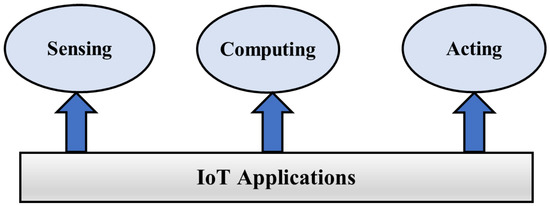
Figure 1.
The properties’ IoT applications.
3.1. IoT Learning Modules
As illustrated in Figure 2, the learning modules developed at PVAMU addressed technical knowledge and skills relevant to building IoT systems. The modules have significant practical emphasis in that 75% of the technical content delivered during lab sessions required students to complete exercises involving system design, device programming, and cloud development.
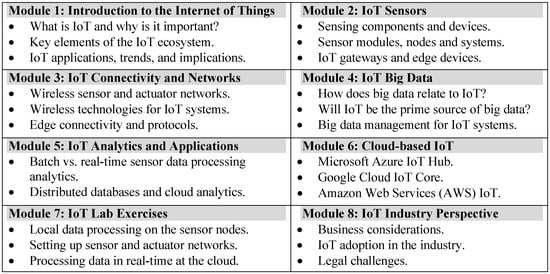
Figure 2.
The IoT learning modules.
The modules were used to create a new course that focuses on IoT for our upper-level undergraduate students at PVAMU. The guidelines for developing the new course were: (i) Hardware used should be off-the-shelf and ready to go; (ii) Distributed and parallel computing concepts should be essential components of the course; (iii) Low power and memory requirements should be a critical design criterion; and (iv) Multiple sensors should be used.
Learning outcomes were as follows. On completion of the developed course, students should be able to:
- Explain the definition and usage of IoT systems in different contexts;
- Understand where the IoT concept fits within the broader Distributed Intelligent Computing domain;
- Differentiate between the levels of the IoT stack and be familiar with its technologies and protocols;
- Apply the knowledge and skills acquired during the course to build and test a complete, working IoT system involving prototyping, programming, and data analysis;
- Discuss the role of big data, cloud computing, and data analytics in a typical IoT system;
- Implement research-based assignments and lab activities that deeply engage students in IoT practices.
3.2. Introducing IoT Innovation in Three Courses
In addition to the new course developed, learning modules were added (shown in Figure 2) to three fundamental computer science courses. The modules are stand-alone, independent, and can be integrated into the CS program’s fundamental and advanced courses. The following courses were targeted in the CS core curriculum, which every student must take to obtain a CS-Major degree (recent enrollment figures also provided for context):
- COMP 3043 Computer Organization. This course examines computer organization and architecture, based on the idea that a computer is regarded as a hierarchy of levels, starting from high-level programming languages and operating systems to the low-level digital logic circuit and sensors. The learning modules that were integrated into this course showed students the connection of all the elements of the whole computer system. This enabled them to see the entire picture of a computer application. Topics included gates, logic circuits, processors, memory, I/O, micro-architecture, instruction set architecture, operating system machine level, and assembly language. The latest course enrollment was 32 students in Fall 2022.
- COMP 4113 Programming Languages. This course provides an overview of various programming languages, syntactic and semantic specification, virtual machines, and language design. It also considers the imperative, object-oriented, functional, and declarative language paradigms. The course examines formal grammars, including Backus–Naur Notation (BNF). It studies several programming languages. The latest course enrollment was 40 students in Spring 2022.
- COMP 4123 Computer Networks. This course provides an overview of computer systems networking. Topics: Local Area Networks (LAN) and Wide Area Networks (WAN), communications software, the architecture of networks, and network protocols. The latest course enrollment was 43 students in Fall 2022.
3.3. IoT Innovation Laboratory
We built an IoT innovation lab equipped with the necessary hardware and software components to offer hands-on environments to develop real-world IoT applications. This lab is used to train students with practical applications and strengthen their hands-on skills and is the first of its kind at PVAMU. It serves as a hub for students and researchers at the Roy G. Perry College of Engineering to focus on training, research, innovation, and collaborative learning of IoT technologies.
The lab is open to CS and Electrical and Computer Engineering students at PVAMU, bringing together students from various disciplines to engage in thought leadership, breakthrough research, hands-on investigation, and knowledge-sharing activities. We aim to enrich the student’s learning environment, foster more profound understanding, accelerate innovation and change, help students meet the latest workforce requirements, and advance successful deployment and adoption of IoT among HBCU institutions.
The laboratory includes the following IoT devices and software:
- Variety of IoT end-devices: temperature, wind speed and direction, solar radiation, leaks monitoring, accelerometer, GPS, proximity, motion, soil moisture, dew point sensors, microphone, magnetometer, gyroscope, pressure, humidity, light sensor;
- IoT gateways and hubs: NXP Pico series, Zigbee, CoAP Gateway, Google Home;
- IoT development kits: Android Things development kit equipped with NXP i.MX7D platform, LoRa IoT development kit;
- IoT simulators and software: Netsim, VisualSim Architect, BevyWise, Ansys.
3.4. IoT Lab Experiments
The following are two sample IoT lab experiments that were used in the new IoT course.
3.4.1. Developing an IoT Camera System Using Raspberry Pi and/or Android Phones
In this lab experiment, students learned how to use Raspberry Pi and Android devices to develop a home security camera system using IoT technologies and uBeac [15]. This lab experiment works best with multiple cameras or phones to help in monitoring all areas of a house or property. uBeac is an IoT platform for centralized digital transformation, data integration, and visualization. uBeac’s IoT hub allows users to connect, process, and securely visualize real-time data. In this lab, students use the IP Webcam App to turn Android phones into a camera network with multiple viewing options. Students use the following hardware and software components to complete this experiment: (1) Android device(s) (e.g., phone or tablet); (2) Raspberry Pi devices; (3) USB cameras; (4) IP Webcam App [16], and (5) an uBeac IoT platform free subscription.
- Step 1:
- After installing the Webcam App, students need to set up the Android devices. Then, they can adjust the video preferences settings as needed and start the video streaming. Once the server is started, students are able to see two URLs (HTTP and HTTPs) that could be used to view the video feed remotely, as shown in Figure 3.
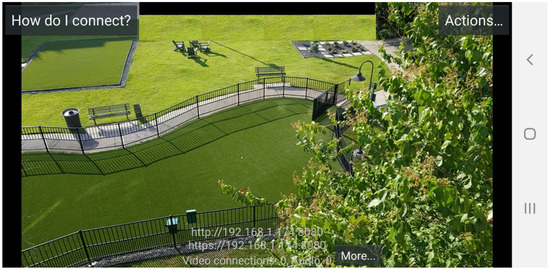 Figure 3. IoT Lab Experiment 01: Remote Video Streaming.
Figure 3. IoT Lab Experiment 01: Remote Video Streaming.
- Step 2:
- For setting up the Raspberry Pi and the camera, open the desktop of the Raspbian and connect to a WiFi network. The Raspbian OS has to be updated to the latest version. To do that, type in the command shell sudo apt-get update and sudo apt-get upgrade one at a time. Then, install the Motion Software by typing in this command sudo apt-get install motion. To check that the camera is detected by the Raspbian OS correctly, type in the command lsusb, and the camera name should be displayed on the command window.
- Step 3:
- After the installation is complete, students need to make some changes in the motion configuration file by typing in this command sudo nano/etc/motion/motion.conf. Then, make these changes in the motion.conf file:
- •
- Make sure daemon is ON;
- •
- Set framerate anywhere in between 1000 to 1500;
- •
- Keep Stream_port to 8081;
- •
- Stream_quality should be 100;
- •
- Change Stream_localhost to OFF;
- •
- Change webcontrol_localhost to OFF;
- •
- Set quality to 100;
- •
- Set width & height to 640 & 480;
- •
- Set post_capture to 5;
- •
- Press ctrl and x to exit. Type y to save and enter to conform.
Next, type in the command sudo nano/etc/default/motion, then make the following change in the file Set start_motion_daemon to yes. To start the Motion Server, take the following two steps: (i) Type in the command sudo service motion restart and press enter; and (ii) Type in the command sudo motion and press enter. Now, the motion server is ready.
- Step 4:
- Create a dashboard at uBeac to enable students to monitor all their cameras at the same time in one place. Having a dashboard to visualize the incoming sensor data are helpful, especially if students want to analyze and utilize the sensor data. Signing up with uBeac is simple. Students need to add their unique namespace and email address and create a password to get started. To create a uBeac dashboard, go to the Dashboards module and add a new dashboard (see Figure 4). Then, pick a name for the dashboard and click submit. A blank dashboard will appear, which you can customize however you wish. On the top right corner of the dashboard page, click the clipboard icon to start editing the dashboard.
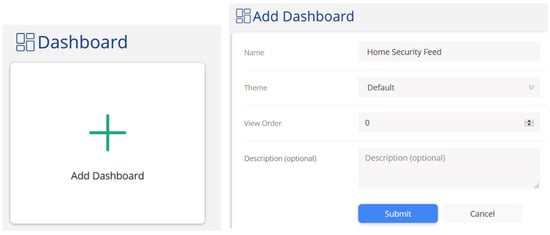 Figure 4. IoT Lab Experiment 01: Adding a Dashboard.
Figure 4. IoT Lab Experiment 01: Adding a Dashboard.
Students can select widgets such as indicators, charts, and device trackers to help them visualize their sensor data. For this experiment, we used the raw widget. Drag and drop the raw widget anywhere on the dashboard. Then, click on Connect to Data, and you will be able to edit the widget. Then, go to the Advanced tab and write down the HTML script, shown in Figure 5, to display the camera. Students need to replace the IP address with their phone’s IP address. Figure 6 illustrates the live video stream generated from two phones and one Raspberry Pi device in the same dashboard.
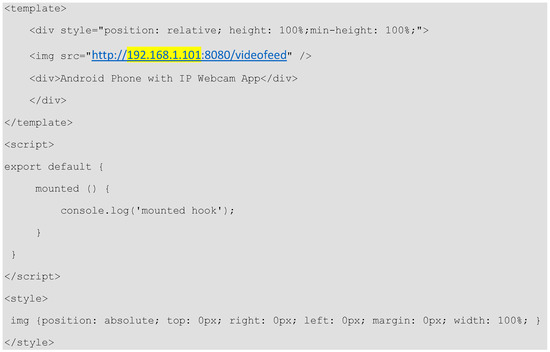
Figure 5.
IoT Lab Experiment 01: HTLM Code.
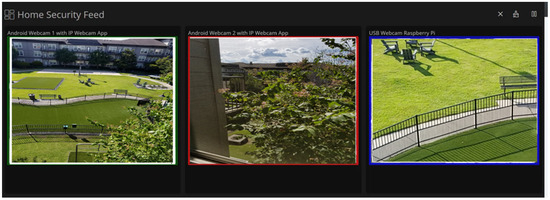
Figure 6.
IoT Lab Experiment 01: Live Video Stream.
3.4.2. Controlling IoT LED Using Raspberry Pi with a Button
In this lab experiment, students learned how to use Raspberry Pi to control a Light Emitting Diode (LED) using a Raspberry Pi’s General-Purpose Input Output (GPIO) with a push-button. When the Raspberry Pi is turned on, the LED will turn on; once the button is pressed, the LED will turn off. As shown in Figure 7, students will use the following hardware components to complete this experiment: (1) Raspberry Pi Device; (2) LED; (3) Resistor 330 ohm; (4) Breadboard; (5) Male/Female Jumper Wires; and (6) Tactile Push-Button.
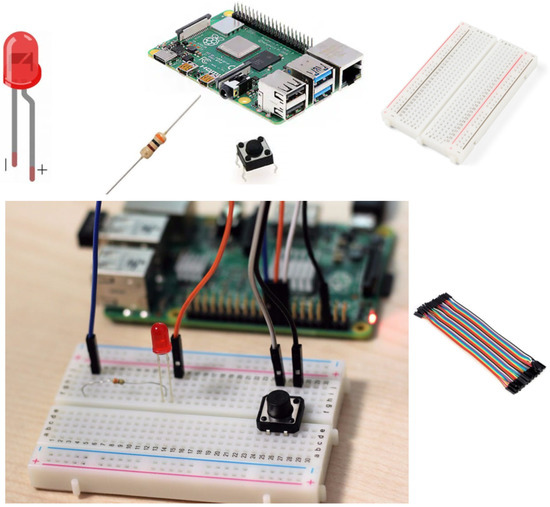
Figure 7.
IoT Lab Experiment 02.
- Step 1:
- Connecting the Circuit. The Raspberry Pi must be turned off until the circuit is connected to avoid accidentally damaging any components. To build the physical circuit, start by inserting the hardware components into the breadboard, as follows:
- •
- LED: The LED has two legs. The longer leg (anode) is always connected to a positive supply. The shorter leg (cathode) is always connected to the ground;
- •
- Resistor: A resistor is needed to limit the amount of current in the circuit. Without the resistor, the current flow through the LED will be much larger than required, which may damage the circuit;
- •
- Button: The push-button has four legs. Figure 8 shows the internal connections of four pins. There is a direct connection between A and B, and between C and D. When the button is pressed, A-C and B-D pairs are getting shorted, which means the circuit is switched off, so the LED will turn off;
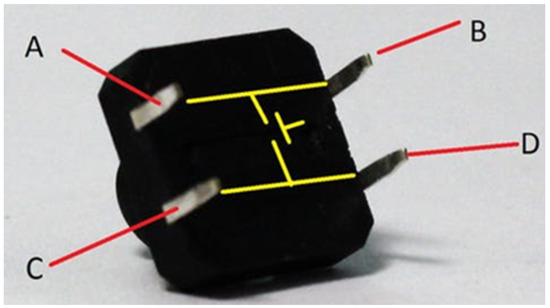 Figure 8. IoT Lab Experiment 02: Tactile Push-Button.
Figure 8. IoT Lab Experiment 02: Tactile Push-Button. - •
- Connect the cathode (shorter leg) of the LED in (row 12, column e) and the anode (long leg) in (row 10, column e). Make sure that the long leg is placed towards the top of the board;
- •
- Connect the resistor to the breadboard from (row 10, column d) to (row 5, column d);
- •
- Use a male-female jumper wire to connect the GPIO’s ground (Pin 6), see Figure 9, to the first hole in the -rail (marked in blue) on the breadboard;
 Figure 9. IoT Lab Experiment 02: Raspberry Pi GPIO.
Figure 9. IoT Lab Experiment 02: Raspberry Pi GPIO. - •
- Use another male-female jumper wire to connect the Pin 7 (GPIO4) to (row 5, column a) in the board;
- •
- Place one male-to-male jumper wire between the -rail and column a on row 12;
- •
- Connect the button into the breadboard in the orientation that leaves just one free row between the pins. Place it across the gap in (row 30, column f), (row 30, column e), (row 32, column f), and (row 32, column e);
- •
- Place one male-to-male jumper wire between the -rail and column a on row 30;
- •
- Use another male-female jumper wire to connect the Pin 11 (GPIO17) to (row 32, column a) in the board.
Figure 10 illustrates the completed circuit. At this point, the Raspberry Pi device can be turned on.
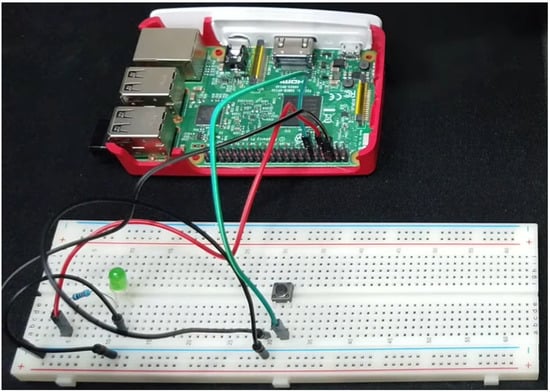
Figure 10.
IoT Lab Experiment 02: Completed Circuit.
- Step 2:
- Writing the Python Code: Now, it is time to write the Python code that will turn on/off the LED, as follows:
- •
- Open a terminal in the Raspberry Pi;
- •
- Create a new file named led_button.py by typing this command: nano led_button.py;
- •
- Then, write the code shown in Figure 11 in the led_button.py file. This code will turn the LED oby default, and then turns it off when the button is pressed;
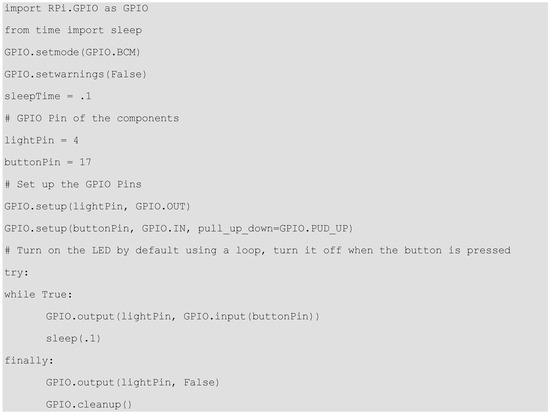 Figure 11. IoT Lab Experiment 02: Python Code.
Figure 11. IoT Lab Experiment 02: Python Code. - •
- Note that the default value of GPIO.input(buttonPin) is true when the button is released;
- •
- Exit the file by clicking on CTRL X;
- •
- Run the program in the terminal using this command: python led.py.
The experiment is complete; the LED should be turned on and off when the button is released and pushed down.
4. IoT Ecosystem
The developed IoT ecosystem offers high-level primitives supported by a middleware implementing fundamental mechanisms required by IoT applications, allowing students to focus on application-specific concerns. In [17], the authors of this article built mechanisms to support interactions in crowd-sourced applications. They also targeted broader challenges in programming and efficiently supporting the sensing needs of IoT applications [18,19,20]. In addition, they developed ShareSens [21], a mechanism which opportunistically economizes on the collection of sensor data, by merging sensing requirements of multiple applications, thereby achieving significant power and energy savings. Another project, ModeSens [18,22], supports multi-modal sensing by automatically detecting sensing mode changes to avoid unnecessary sensing. ShareSens and ModeSens can also work together to optimize dynamically evolving sensing needs of IoT applications. The authors of this paper built on this work to implement an IoT ecosystem and platform which will ease the burden for students to initiate and manage applications using a simple GUI.
Figure 12 illustrates how the distributed run-time system for the proposed IoT ecosystem is organized with parts executing on the sensing devices at the sensing side, on remote servers at the cloud side and on users’ computers locally. This section discusses these three parts separately:
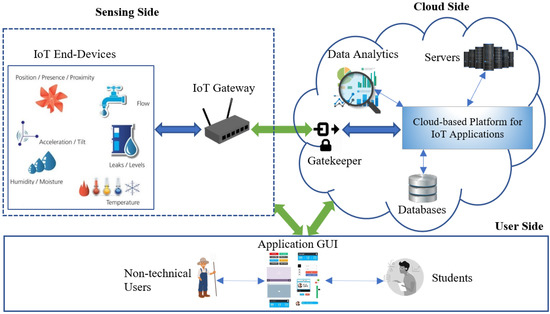
Figure 12.
The IoT Ecosystem Architecture.
- Sensing Side: At the sensing side, data are collected from a variety of IoT end-devices including soil moisture, temperature, wind speed and direction, solar radiation, leaks monitoring, accelerometer, GPS, proximity, motion, dew point sensors, etc. IoT gateways are used to aggregate these data and coordinate the connectivity of the end-devices to each other and to the cloud side. The gateway keeps aggregating the received sensor data until a sufficient number of them have been received to detect an interesting event such as a change in the level of soil moisture in an agricultural field. Gateways either send updates periodically or when they observe a new event, to the platform at the cloud side through the Gatekeeper;
- Cloud Side: At the cloud side, the platform receives the aggregated events through the Gatekeeper, which implements some security mechanisms to ensure that the incoming messages are legitimate. The aggregated events are then stored in distributed databases at the cloud side. The platform also sends a set of parameters to gateways advising them on how to detect events, construct their messages, and how often to send them (once or periodically, how frequently, etc.);
- User Side: Non-technical users (e.g., farmers) and students will be able to quickly initiate and manage IoT applications using a web-based Graphical User Interface (GUI) from their personnel computing devices such as PCs and Smartphones. An application is initiated by a user who uses the GUI to send a request to the platform with the intent of creating a new application. For example, consider a smart farming application, running on top of the proposed system, which enables a farmer to monitor the field conditions from anywhere with the help of sensors, as well as automating the irrigation and harvesting. For controlling the environment in the field, different sensors that measure the environmental parameters according to the plant requirement will be used. The GUI will help users to remotely access the deployed IoT system. It eliminates the need for constant manual monitoring. This design provides cost-effective and optimal solutions to farmers with minimal manual intervention.
For evaluating the programmability advantages of this IoT ecosystem, this section presents different IoT applications that could be easily programmed and managed by the proposed IoT approach.
4.1. IoT App 1: Smart Air Quality Monitoring System
Over the last century, there has been an exponential growth in heavy industries, car emissions, chemicals from factories, smoke, and dust. The carbon footprint of this industrial revolution has caused critical problems for the environment and air quality [4,5]. In addition, the effect of air pollution has severe consequences on our health. For instance, it can cause serious diseases such as asthma, lung disorders, and cancer. Therefore, there is a persistent need for air quality monitoring systems that can detect hazardous emissions in real-time. However, air quality monitoring is performed by astronomical, expensive scientific instruments permanently installed and professionally maintained at a relatively small number of fixed locations.
In the era of IoT, it is more possible than ever to implement innovative systems using cheap sensors such as the one for air quality monitoring. The authors managed to realize such a system by prototyping a smart IoT system for measuring the density of CO, CO, O, PM2.5 dust, temperature, humidity, as well as detecting the existence of natural gas. As shown in Figure 13, we used a Raspberry Pi 3 and various sensors such as gas, temperature, leak detection, and airflow sensors. The system can also issue a warning signal when hazardous gas is above a certain predefined threshold. The system is designed to calculate and display comprehensive air quality measurements, which are sent to the cloud for further processing and publishing purposes. It also allows users to use their smartphone to monitor the air quality from anywhere.

Figure 13.
IoT App 1. A Snapshot of the Air Quality Monitoring System.
4.2. IoT App 2: Smart Garage Door Monitoring and Operating System
The authors also developed a smart garage monitoring system using cheap IoT sensors and materials. This system allows users to perform the following tasks from anywhere and at anytime through their smartphones: (i) Monitor garage door status to tell whether it is open or closed; (2) Operate (open/close) the garage door; (2) Check the presence of parked vehicle inside the garage but only if the door is closed; (4) Monitor the temperature and humidity of garage; and (5) Report the open-close history of the garage door with timestamp attached. Figure 14 shows a snapshot of the developed prototype mounted on the ceiling of a garage for testing purposes. A mobile app was also developed which can be easily used by users to perform the above tasks.
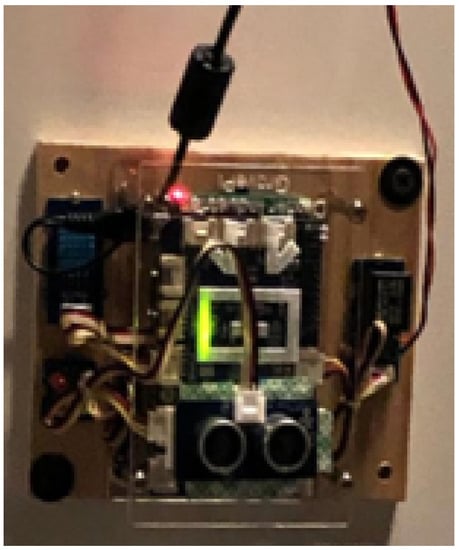
Figure 14.
IoT App 2. A Snapshot of the Smart Garage Door Monitoring and Operating System.
5. Assessment and Evaluation
The implementation of the course and modules was evaluated. Qualitative and quantitative data regarding student experience were gathered at regular intervals each academic year. In the 2020–2021 school year, information was gathered from the first set of students who experienced the IoT curriculum updates. In the 2021–2022 school year, data from the second set of students were compiled and analyzed.
Exquiri Consulting, LLC agreed to undertake the external evaluation for this work in January 2021. Exquiri Consulting is US-based company that provides external evaluation service for grant funded projects and conducts research regarding areas of challenge in higher education. Student surveys were developed and deployed in the fall of 2020. Exquiri met and corresponded with the research team, contributed to revising surveys and establishing and continuing research compliance documentation, conducted interviews with student workers, completed data analysis, and compiled evaluation reports. Exquiri continued consulting with the research team in the 2021–2022 school year. This section summarizes the data and findings from all sources for both years.
5.1. Data Gathering
A set of pre- and post-participation surveys for the new IoT course and revamped courses was prepared. Students who worked on this research work were interviewed to understand their experience and learning. Survey data in the first and second years included student self- reports of select demographics, the way they heard about the class they were taking, their reasons for taking the course, awareness and knowledge of IoT, interest in IoT, expectations for the course, and learning achieved. Interviews with student workers focused primarily on research processes, logistics, and implementation patterns and findings, which, while helpful to the research team, are not presented here. Data regarding learning achieved by student workers have been included.
In 2020, the data gathered were analyzed using descriptive statistics and tabular representation and were considered aggregated as performance tallies for this research work. The pre-participation responses provided baseline values. Survey revisions made use of inferential statistics possible with the 2021 and 2022 data. Qualitative data existed as responses to short answer questions on the surveys, written material and discussion notes from interaction with the research team, and notes taken during interviews with the student workers.
The 2020 survey responses were anonymous, so pairing pre- and post-instruction sets as repeated measures was impossible. The surveys also employed nominal and ordinal scales rather than interval scales. As a result, the percent of the total respondent pool was reported and compared for the difference in pre- and post-participation submissions. Without interval scales, additional statistical analysis was not possible. The revision of surveys for 2021 included shifting to rating scales and including student ID numbers, both of which would facilitate use of inferential analysis. The student ID was included to make repeated measure assessment possible. Use of the student ID numbers revealed the pre- and post-participation samples had significant overlap, as much as 80.0%, but the small size of the samples made unpaired comparisons preferable as the number of parties submitting both pre- and post-participation responses was small (less than 20 in every case).
5.2. Survey Findings and Interpretation of Results
In both academic years, the pre- and post-participation surveys were not mirror images of each other. Some measures, such as how the student heard about the course, were not repeated as asking them a second time would have no merit. There were also queries specific to learning achieved and recommendations based on experiences in the course that could not be asked on the pre-participation instrument. The evaluator sorted the questions into a sequence based on the topics addressed. Pre- and post-instruction responses were grouped together whenever possible. The sequence of topics is as follows:
- How the student heard about the course (pre-participation survey in project YR1);
- Why the student chose to take the course (pre-participation survey in project YR1);
- What the students expected to encounter (pre-participation survey both years);
- Pre-instruction expectations of IoT course modules (pre-participation survey both years);
- The student’s current awareness of IoT (pre-participation survey both years);
- Knowledge and current understanding of, interest in learning about, and interest in working in IoT (pre- and post-participation surveys both years);
- Student interest in pursuing a career in IoT (pre-participation survey both years).
- Impact of course modules on student career trajectory;
- The contribution of class lectures and projects to learning (post-participation both years);
- Specific forms of learning achieved in the course (post-participation both years);
- Student recommendations to improve the course (post-participation both years);
- Additional feedback provided by students (post-participation both years).
In 2020–2022, the IoT learning modules were integrated in COMP 4113, COMP 3043, COMP 5023, COMP 1337, COMP 2336 and COMP 5313. In addition, the new IoT course (COMP 4073) was offered for the first time in Spring 2021. Figure 15 provides statistics about the characteristics of the respondents from these groups.
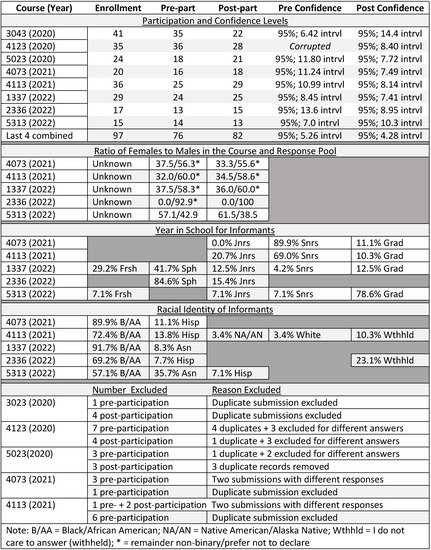
Figure 15.
Statistics about Student Participation, Informants and Excluded Submissions.
As shown in Figure 15, female students were about a third of each sample in 2020 and 2021, with up to 8% of informants identifying as non-binary or preferring not to state a gender identity. The 2021–2022 data included three very different proportions of females, with no females in the COMP 2336 sample, 37.5% in COMP 1337 sample, and 57.1% in COMP 5313 sample. Non-binary and/or prefer not to respond submissions for gender occurred at approximately the same level in 2021–2022 as in 2020–2021.
The majority of respondents in 2020–2021 were seniors, with approximately 21% of informants from COMP 4133 being juniors. Graduate students were 10.3% and 11.1% of the collected 2020–2021 samples. Diversity in academic rank in the classes both expanded and contracted in the 2021–2022 samples. COMP 1337 had the widest spread of academic ranks of any course offered, and COMP 2336 had the smallest, with 84.6% of informants reporting they were sophomores. Overall, the diversity in academic rank is positive as it allows generalization of the results.
5.2.1. Q1—How Students Heard about the New IoT Course and Why They Were Taking It
The 2021 pre-participation surveys for COMP 4073 included questions about how students learned the course was being offered and why they chose to take the class. Quantitative results for this question are presented in Figure 16. Written explanations submitted when students selected Other were as follows: (1) “I preferred to take IoT rather than Smart App for my required upper-level elective” and (2) “The course was recommended by my advisor”. These align with the most frequently selected fixed-response options, “IoT is an interesting topic” and the most frequently selected response to how the students learned about the course.

Figure 16.
Survey Analysis: Q1—Why Students Elected to Take the Course?
5.2.2. Pre-Instruction Expectations for IoT Course Modules
In 2020, students in three classes were asked, prior to instruction, what their expectations for the class modules were. The responses are summarized in Figure 17. The figures in parentheses following each statement in the table are the number of individuals who provided the response. The responses are listed from most frequent to least frequent for each course. There is no significance to the order in which responses submitted the same number of times are listed. Responses of no expectations/no idea, and the counts for them, are listed at the bottom of all three columns.
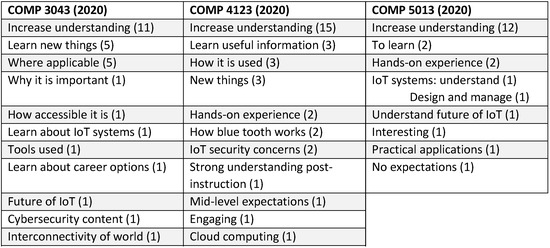
Figure 17.
Survey Analysis: Pre-participation Expectations of the IoT Modules.
Overall, students hoped that the IoT modules would: (1) provide them with a good introduction to IoT, (2) include opportunities for them to learn new things, (3) provide hands-on experiences, (4) provide practical insight about IoT (e.g., why vital, where used, how used), (5) help them understand IoT systems and their future, (6) provide insight into specific applications (i.e., Bluetooth) and issues (i.e., security), and (7) be interesting.
5.2.3. Current Awareness of IoT
Pre-participation surveys for COMP 3043, COMP 4123, and COMP 5013 in 2020 included a query about the student’s current awareness of IoT. The question asked for the best descriptor of understanding and used a customized Likert scale that was nominal and without consistent and defined intervals between each category. Because this was a pre-participation measure, even though it was worded differently than the post-participation measure, it can be seen as a measure of awareness (i.e., knowledge of the presence or prevalence of something). With this in mind, responses were grouped with those regarding the post-participation query about awareness of IoT technology.
The response patterns, by class and as a cumulative set, indicate that student awareness of IoT increased as shown in Figure 18. In two of the three instances, the largest percentage of pre-participation responses occurred for the lowest possible rating, “never heard anything about”, but shifted up three categories to the next to highest rating, “know some basic concepts and applications”. The exception was for COMP 4123 for which the pre-participation rating with the largest percentage was “know only a few things about”. Individually and as a cumulative set, the responses show strong increases in awareness of IoT among participating students.
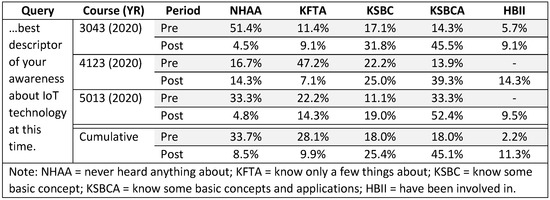
Figure 18.
Survey Analysis: Current Awareness of IoT.
5.2.4. Knowledge of IoT Pre- and Post-Participation
A three-part question regarding learning about IoT, working on IoT projects, and pursuing a career in IoT was asked in both 2020 and 2021. Students were asked about their knowledge of IoT technology in computing in the pre- and post-participation surveys in 2020. Unfortunately, the question prompts were worded differently and, as a result, the students did not respond regarding the same construct on the two surveys. The first prompt was “Use the scale to indicate your knowledge and interest in IoT Technology: Knowledge of IoT technology in computing”. The post-participation prompt was “Use the scale to indicate the extent of gains made as a result of the IoT concepts you learned and/or IoT projects you might have worked on in this course: Knowledge of IoT Technology in Computing”. Because of this difference, the two scores cannot be used to measure the change in perceived knowledge.
In 2021 and 2022, the surveys included a request for a rating of the student’s current understanding of IoT technology. This was a similar query to the rating of knowledge of IoT from 2020. The 2022 course results are presented in Figure 19. The largest percentage of respondents for COMP 3043 felt they possessed no knowledge of IoT, but for COMP 4123 and COMP 5013, the most common response was the student knew a little. Pre-participation ratings for 2021 produced a similar result, with a mean slightly above the mid-point. To summarize, students in 2020 and 2021 reported limited knowledge of IoT technology in computing before the course.

Figure 19.
Survey Analysis: Current Understanding of IoT.
For the three courses taught in 2020, 77% or more of informants indicated knowledge gains of somewhat or better with a lot as the selection made most frequently for COMP 4123 and COMP 5013 (see Figure 20). Similar results were achieved in 2021 with a mean rating of 8.11 on a ten-point scale for level of understanding post-instruction for COMP 4073 and increases in mean and median with a decrease in standard deviation for COMP 4113 from pre- and to post-instruction measures. Results regarding a change in understanding, pre- versus post-instruction for COMP 1337, COMP 2336, COMP 4113, and COMP 5313 support the assertion that substantial learning was achieved as three of the four comparisons proved to be statistically significant, as did all of the analyses of combined sets.
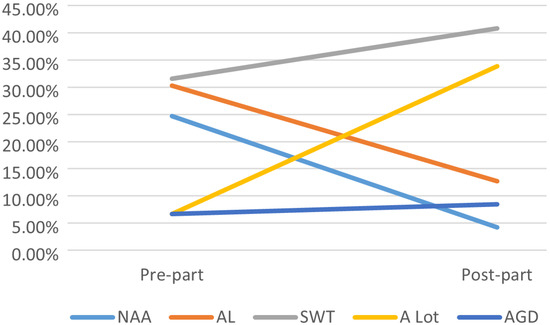
Figure 20.
Survey Analysis: Pre- to Post-Participation Changes in Ratings of Knowledge of IoT Technology.
5.2.5. Interest in an IoT Career
The 2020 pre-participation surveys included a question about student interest in “pursuing a career in IoT technology”. This query employed a standard, five-point Likert scale extending from strongly disagree to strongly agree with neutral as the mid-point option. For the three classes, the neutral option was the most frequent submission, although nearly 38% of the students agreed or strongly agreed and only a little over 11% disagreed or strongly disagreed.
In 2021 and 2022, different scales were used, but the ten-point scale ratings for COMP 1337, COMP 2336, COMP 4073, COMP 4113, and COMP 5313 indicate similar levels of interest. The mean for the combined set was 6.26 (see Figure 21), the median rating was 7.0, and the standard deviation for the ratings was 2.77. Thus, before instruction, the average informant was neutral to intrigued by the possibility of a career in IoT.
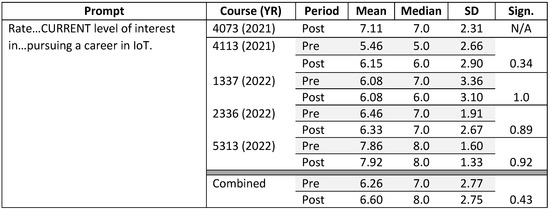
Figure 21.
Survey Analysis: Interest in a Career in IoT Technology 2021 and 2022.
The surveys in 2021 and 2022 included another career-related question. Students were asked to rate their level of interest in pursuing a career in IoT. This was a post-participation-only query for COMP 4073 but included on both the pre-and post- instruction survey for COMP 4113 and all the courses offered in 2022. The responses from COMP 4073 parallel those from 2020. Students were interested in a career but not at top-of-the-chart levels. The pre- to post-instruction ratings in 2021 and 2022 show student intent to consider work in IoT, both before and following instruction, and occurred at similar levels, so that differences were not statistically significant (see Figure 21). The response regarding the four IoT career orientations helps explain this result. Students are intrigued by IoT but are almost equally uncertain about how this aspect of computer technology will be a part of their future careers. These responses align well with the submissions regarding interest in an IoT career, as the interest is moderate before and following instructions. The students were open to involvement but wanted to wait to see how IoT develops and to what extent it might be a part of their futures.
5.2.6. Contribution of Lectures and Projects to Learning IoT
The students who took the IoT courses in 2020 and 2021 were asked to rate “how much each of the following…added to your understanding of IoT technology in computing?”. The two ideas completing the prompt were class lectures on IoT technology and working on an IoT technology project in this class. Figure 22 and Figure 23 show the results.
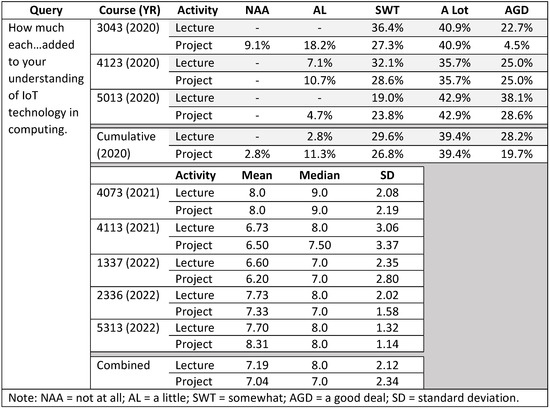
Figure 22.
Survey Analysis: Post-Instruction Reports show the Impact of IoT Lectures vs. Projects.
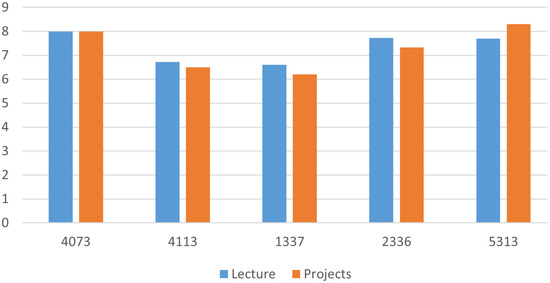
Figure 23.
Survey Analysis: Mean Rating for Impact of IoT Lectures vs. Projects.
In 2020, students reported substantial impact for both between 90% and 100%, indicating at least some addition to understanding resulting from the activity. Only COMP 3043 had students who felt the projects did not impact their understanding of IoT. In the other two classes and for both categories, 100% of students saw at least a little benefit from the lectures and projects. In 2021 and 2022, the same question yielded similar results with high mean and median ratings, although standard deviations ranged from 1.14 to 3.37. Overall, nearly every student reported at least a little addition to their understanding of IoT from both lectures and projects, with 100% in that category for five of six measures in 2020 (see Figure 22).
5.2.7. Specific Forms of IoT Learning
A multi-part question on the post-participation survey asked about three different forms of IoT knowledge in 2020 and 2021. This was changed to four forms of learning for the courses with modules in 2022. Response tallies for 2020 were considered as a percent of total responses in each class and cumulatively for each question. When considered as cumulative sets, the post-instruction outcomes for 2020 were encouraging:
- 66% of the students agreed or strongly agreed they were able to describe key concepts related to IoT;
- 70% of respondents reported an increase in facility defining and explaining IoT concepts;
- 71.8% of informants agreed or strongly agreed that their understanding of IoT systems had increased;
- Approximately 67% of students reported their interest in a career in IoT had been stimulated;
- Nearly 72% of the informants said they would recommend the content they had been taught.
Figure 24 lists the outcomes for the four queries on the 2021 and 2022 surveys for courses in which IoT modules were taught. Since a ten-point rating scale was employed with these questions and the pre- and post-instruction questions were the same, it was possible to complete statistical analysis. Many of the pre- to post-instruction comparisons proved to be statistically significant, with a high percentage strongly significant (). As noted above (Figure 22), students who took the courses reported increasing their overall understanding of IoT. The data for overall understanding of IoT for COMP 1337, 2336, 4113, and 5313 in 2021 and 2022 (Figure 22) show a similar pattern that occurred at statistically significant levels.
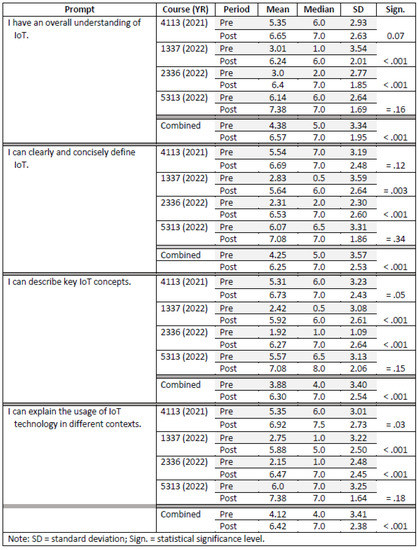
Figure 24.
Survey Analysis: Specific Forms of Learning Regarding the IoT Concepts: COMP 4113 in Spring 2021.
Students were less certain of their ability to clearly and concisely define IoT and, while there were pre- to post-instruction differences, two of the four comparisons did not prove to be statistically significant (Figure 24). Since the students were mostly new to IoT topics, this should not be seen as a shortcoming in the IoT curriculum. Early in their experience with a topic, individuals often feel they cannot provide a concise overview of it. It is also important to note that statistical significance in comparisons of small groups is hard to achieve. The differences were strongly significant when combined as a complete set of responses, a pattern which broadened the consideration and softened the impact of individual choices.
5.2.8. Student Recommendations for Improvement
Near the end of the post-participation survey in COMP 1337, COMP 2336, COMP 4073, and COMP 5313, students were asked what recommendations they had for improving the course. This was a closed-ended, multiple choice question for which the students were to select one of four responses in 2020 and permitted to select all that applied in 2021 and 2022. Figure 25 contains a summary of the responses.
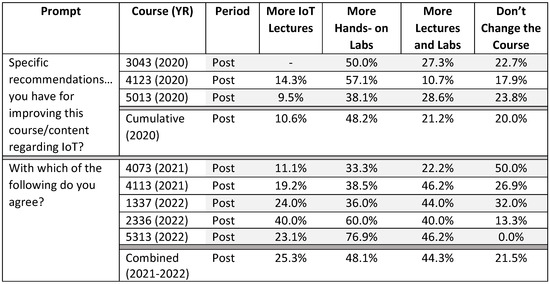
Figure 25.
Survey Analysis: Student Recommendations for Improvement.
The class response patterns showed some variation. Fifty percent of the students in COMP 4073 suggested that no change be made, while over 75% in 5313 advocated for more hands-on labs and all the informants in COMP 5313 felt some change was desirable. These differences can be ascribed to the idiosyncratic nature of each class and possibly, in the case of COMP 5313, it being a graduate-level course. The submissions can be seen as an extension of findings from other questions. The students found the content presented intriguing; they learned from it and, as a result, desired that the experience remain the same or even be expanded. Adding a balance of lectures and practical experience or just more practical experiences was viewed as the desirable means of expanding upon the current curriculum, should it be possible.
Responses to another question also support student perception that the instructional material was valuable. When asked if they would recommend the modules and whether they would recommend them for use with other students, students replied in the affirmative but with mild reservation. This is similar to the responses regarding additions to the course in which a dichotomy between maintaining the curriculum (Figure 24) and adding even more experiences was noted. In each of these cases, the informants appear to have found the content helpful, believed it would be valuable to others, and thought there might be room for some modification but not wholesale change. Graduate students valued the modules more highly than the undergraduates, which may be an anomaly related to the population in COMP 5313 in 2022, representative of greater understanding and, therefore, greater appreciation or some other unknown characteristic.
5.3. Interviews with Student Workers
Two female students, one graduate and one undergraduate, were recruited to work on this research in the first year. One of these students continued with the project in the second year and another student (male) was recruited in 2021. Semi-structured, seven-question interviews were completed in 2021 and 2022.
The student workers reported related areas of responsibility. In 2020, the undergraduate was involved with videos and lab research topics. Her activity was part of the organization and development of the material, while the graduate student was responsible for the implementation of the IoT lab experiments and produced videos that acted as tutorials for the students in the course. Both were clearly successful as the material to which they contributed was a major component of the education process and participating students commented about them. This pattern of testing lab activities, doing literature searches and compiling documentation, and creating supporting or instructive videos was continued in the second year of this research work with similar results.
The student workers were asked if anything could have been done that would have improved their likelihood of success in assigned tasks. All stated they felt they had been successful. The graduate student worker noted that she had advanced experience in areas related to the project courses but that the process of working through and producing videos for labs and providing guidance to students had been a helpful means of reviewing concepts, reinforcing learning, and establishing an understanding of how unanticipated challenges at all levels could arise. The students noted learning a lot about and through the experiments they worked on, data analytics, coding, hardware, and software. The students also reported practical learning regarding the value of communication and coordination of work teams and achieving a sense of purpose regarding passing knowledge on to others.
The student workers were also asked about the long-term learning goals for this research work. All were pleased to have been able to contribute to a process that created a learning environment with the potential to provide beneficial experiences to PVAMU students in the future.
5.4. Study Limitations
None of the course-specific survey response sets met a 95% confidence level with a 5% confidence interval. Thus, the outcomes reported must be considered in that light. In addition, response patterns differed by course in ways that appear to indicate slight differences in the student audiences attracted to each of them. Online instruction in 2021 and 2022, a necessity due to the COVID-19 pandemic, did not prohibit a positive impact on student outcomes or perspectives, although it cannot be known whether the impacts would have been different in a face-to-face setting.
6. Conclusions
This paper provides a case study for implementing an integrated approach that has both foundational and practical contributions to introducing innovative and smart IoT technologies into the CS curriculum to better prepare students to meet the accelerating employment needs in IoT. That goal was achieved at PVAMU by pursuing three objectives: (1) Develop innovative IoT learning modules that can be easily integrated with three existing courses to engage students in educational experience with IoT and use the developed modules to introduce a new project-based course that focuses on smart IoT technologies; (2) Build an IoT Innovation Lab which offers the opportunity for undergraduate students to learn cutting-edge IoT technologies and enriches their learning environment; and (3) Develop an IoT ecosystem that can be used by students for initiating and managing IoT applications. This research work helped to foster innovation by introducing an experiential learning approach. It promoted IoT research and learning experiences for undergraduates at PVAMU providing them new experiences with and expanded motivation to pursue understanding of smart IoT. In addition, it offered these experiences at an HBCU so that under-represented students might be funneled into STEM graduate schools and careers. This paper presents a novel infusion of IoT technologies into the CS curriculum. The proposed approach for incorporating IoT in the CS curriculum is not limited to a stand-alone course on IoT; instead, it is a holistic integration of IoT skills and related technologies throughout the undergraduate program.
The proposed approach was evaluated using quantitative and qualitative data. The results showed that students become more interested in exploring IoT careers in the future. Furthermore, nearly every student reported at least a little addition to their understanding of IoT from both lectures and projects with 100% in that category for five of six measures in 2020 and mean ratings just above seven on a ten-point scale for both constructs in 2021 and 2022. Interestingly, graduate students valued the IoT modules more highly than the undergraduates, which may be an anomaly related to the population in the courses in 2022, representative of greater understanding and, therefore, greater appreciation, or related to some other unknown characteristic.
For on-going work, the research team is working on expanding this research to include Artificial Intelligence (AI) mechanisms to smartly collect, preprocess, and communicate sensor data. Adding AI to the sensing process provides the opportunity to significantly increase the ratio of relevant information content to raw sensor data.
Author Contributions
Conceptualization, A.A.A. and K.B.; methodology, A.A.A.; software, Y.Y.; validation, M.P., Y.Y. and K.B.; formal analysis, A.A.A.; investigation, A.A.A.; resources, A.A.A.; data curation, M.P.; writing—original draft preparation, A.A.A.; writing—review and editing, M.P.; visualization, A.A.A.; supervision, Y.Y.; project administration, A.A.A.; funding acquisition, A.A.A. All authors have read and agreed to the published version of the manuscript.
Funding
This research work is supported in part by the National Science Foundation (NSF) under Grant No. 2011330. Any opinions, findings, and conclusions expressed in this paper are those of the authors and do not necessarily reflect NSF’s views.
Institutional Review Board Statement
The study was conducted in accordance with the Declaration of Helsinki, and approved by the Institutional Review Board of Prairie View A&M University (protocol code 2021-042 and date of approval: 31 March 2021).
Informed Consent Statement
Informed consent was obtained from all subjects involved in the study.
Data Availability Statement
The data and source code are available upon request.
Conflicts of Interest
The authors declare no conflict of interest.
References
- Ahmed, A.A.; Omari, S.A.; Awal, R.; Fares, A.; Chouikha, M. A Distributed System for Supporting Smart Irrigation using IoT Technology. Eng. Rep. 2020, 3, e12352. [Google Scholar] [CrossRef]
- Ahmed, A.A.; Echi, M. Hawk-Eye: An AI-Powered Threat Detector for Intelligent Surveillance Cameras. IEEE Access 2021, 9, 63283–63293. [Google Scholar] [CrossRef]
- Garthner Technical Research. Internet of Things. Available online: https://www.gartner.com/en/information-technology/insights/internet-of-things (accessed on 3 September 2022).
- Hwang, J.; Nkenyereye, L.; Sung, N.; Kim, J.; Song, J. IoT Service Slicing and Task Offloading for Edge Computing. IEEE Internet Things J. 2021, 8, 11526–11547. [Google Scholar] [CrossRef]
- Hwang, J.; Aziz, A.; Sung, N.; Ahmad, A.; Le Gall, F.; Song, J. AUTOCON-IoT: Automated and Scalable Online Conformance Testing for IoT Applications. IEEE Access 2020, 8, 43111–43121. [Google Scholar] [CrossRef]
- PVAMU Ranking. Available online: https://www.pvamu.edu/ir/pvamu-data-3/fact-books-2/2014-2018-fact-book/ (accessed on 3 September 2022).
- Ahmed, A.A.; Reddy, G.H. A Mobile-Based System for Detecting Plant Leaf Diseases Using Deep Learning. AgriEngineering 2021, 3, 478–493. [Google Scholar] [CrossRef]
- What’s New with the Internet of Things? Available online: https://www.mckinsey.com/industries/semiconductors/our-insights/whats-new-with-the-internet-of-things/ (accessed on 3 September 2022).
- The Next, Wave of Job Opportunities Brought to You by the IoT. Available online: https://www.iotna.com/post/the-next-wave-of-job-opportunities-brought-to-you-by-the-iot (accessed on 3 September 2022).
- Global Skills Shortage Threatens IoT Success—Report. Available online: https://www.cbronline.com/news/internet-of-things/global-skills-shortage-threatens-iot-success-report/ (accessed on 3 September 2022).
- Rowland, S.; Sundaram, R. Incorporation of the Internet of Things within the Introductory Course on Microcontrollers. In Proceedings of the IEEE Frontiers in Education Conference (FIE), Lincoln, NE, USA, 13–16 October 2021; pp. 1–4. [Google Scholar] [CrossRef]
- Burd, B.; Barker, L.; Divitini, M.; Guerra, J.G.; Perez, F.A.F.; Russell, I.; Siever, B.; Tudor, L.; McCarthy, M.; Pollock, I. The Internet of Things in CS Education: Updating Curricula and Exploring Pedagogy. In Proceedings of the 23rd Annual ACM Conference on Innovation and Technology in Computer Science Education, ITiCSE 2018, Larnaca, Cyprus, 2–4 July 2018; Association for Computing Machinery: New York, NY, USA, 2018; pp. 366–367. [Google Scholar] [CrossRef]
- He, J.; Lo, D.C.T.; Xie, Y.; Lartigue, J. Integrating Internet of Things (IoT) into STEM undergraduate education: Case study of a modern technology infused courseware for embedded system course. In Proceedings of the IEEE Frontiers in Education Conference (FIE), Eire, PA, USA, 12–15 October 2016; pp. 1–9. [Google Scholar] [CrossRef]
- IBM Insights. Available online: https://www.ibm.com/blogs/internet-of-things/what-is-the-iot/ (accessed on 3 September 2022).
- uBeac: Adaptive IoT Platform. Available online: https://www.ubeac.io/ (accessed on 3 September 2022).
- IP Webcam App. Available online: https://play.google.com/store/apps/details?id=com.pas.webcam&hl=en_CA (accessed on 3 September 2022).
- Moamen, A.A.; Jamali, N. An Actor-Based Middleware for Crowd-Sourced Services. EAI Endorsed Trans. Mob. Commun. Appl. 2017, 3, e1. [Google Scholar] [CrossRef][Green Version]
- Abdelmoamen, A. A Modular Approach to Programming Multi-Modal Sensing Applications. In Proceedings of the IEEE International Conference on Cognitive Computing, ICCC ’18, San Francisco, CA, USA, 2–7 July 2018; pp. 91–98. [Google Scholar]
- Moamen, A.A.; Jamali, N. Opportunistic Sharing of Continuous Mobile Sensing Data for Energy and Power Conservation. IEEE Trans. Serv. Comput. 2020, 13, 503–514. [Google Scholar] [CrossRef]
- Moamen, A.A.; Jamali, N. Coordinating Crowd-Sourced Services. In Proceedings of the 2014 IEEE International Conference on Mobile Services, Anchorage, AK, USA, 27 June–2 July 2014; pp. 92–99. [Google Scholar]
- Moamen, A.A.; Jamali, N. ShareSens: An Approach to Optimizing Energy Consumption of Continuous Mobile Sensing Workloads. In Proceedings of the 2015 IEEE International Conference on Mobile Services (MS ’15), New York, NY, USA, 27 June–2 July 2015; pp. 89–96. [Google Scholar]
- Moamen, A.A.; Nadeem, J. ModeSens: An Approach for Multi-modal Mobile Sensing. In SPLASH Companion 2015: Companion Proceedings of the 2015 ACM SIGPLAN International Conference on Systems, Programming, Languages and Applications: Software for Humanity; ACM: Pittsburgh, PA, USA, 2015; pp. 40–41. [Google Scholar]
Publisher’s Note: MDPI stays neutral with regard to jurisdictional claims in published maps and institutional affiliations. |
© 2022 by the authors. Licensee MDPI, Basel, Switzerland. This article is an open access article distributed under the terms and conditions of the Creative Commons Attribution (CC BY) license (https://creativecommons.org/licenses/by/4.0/).